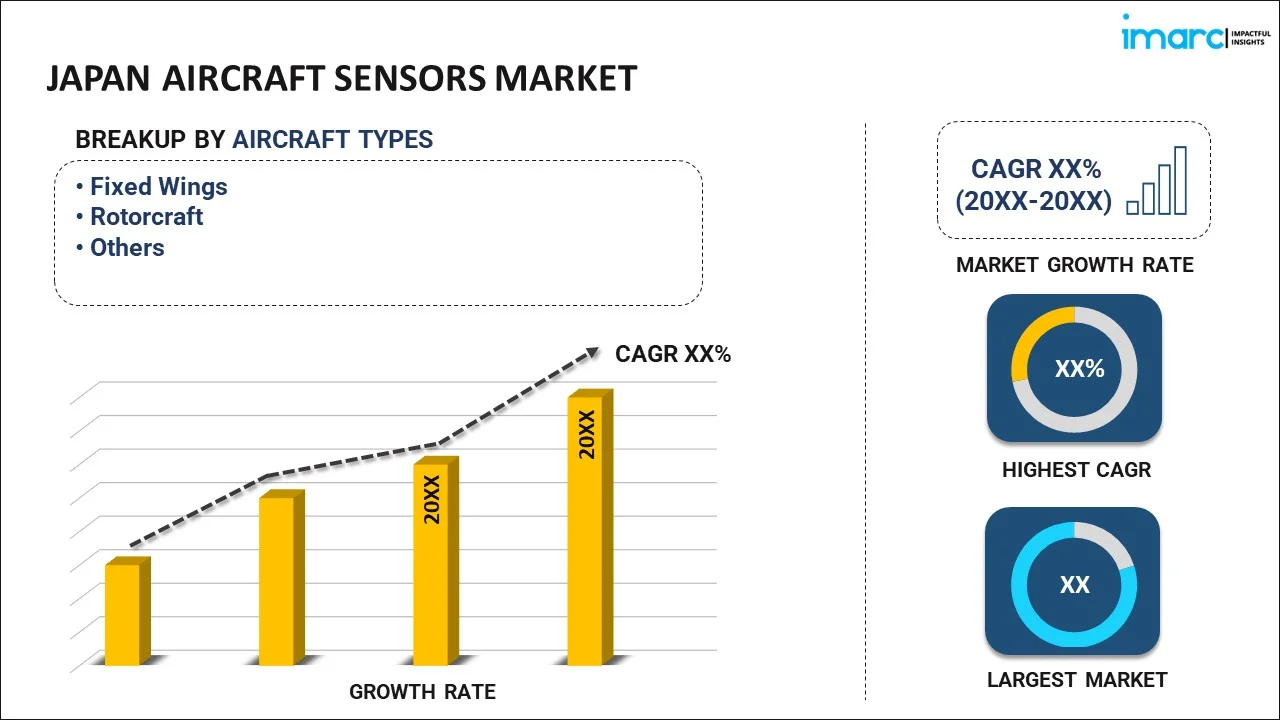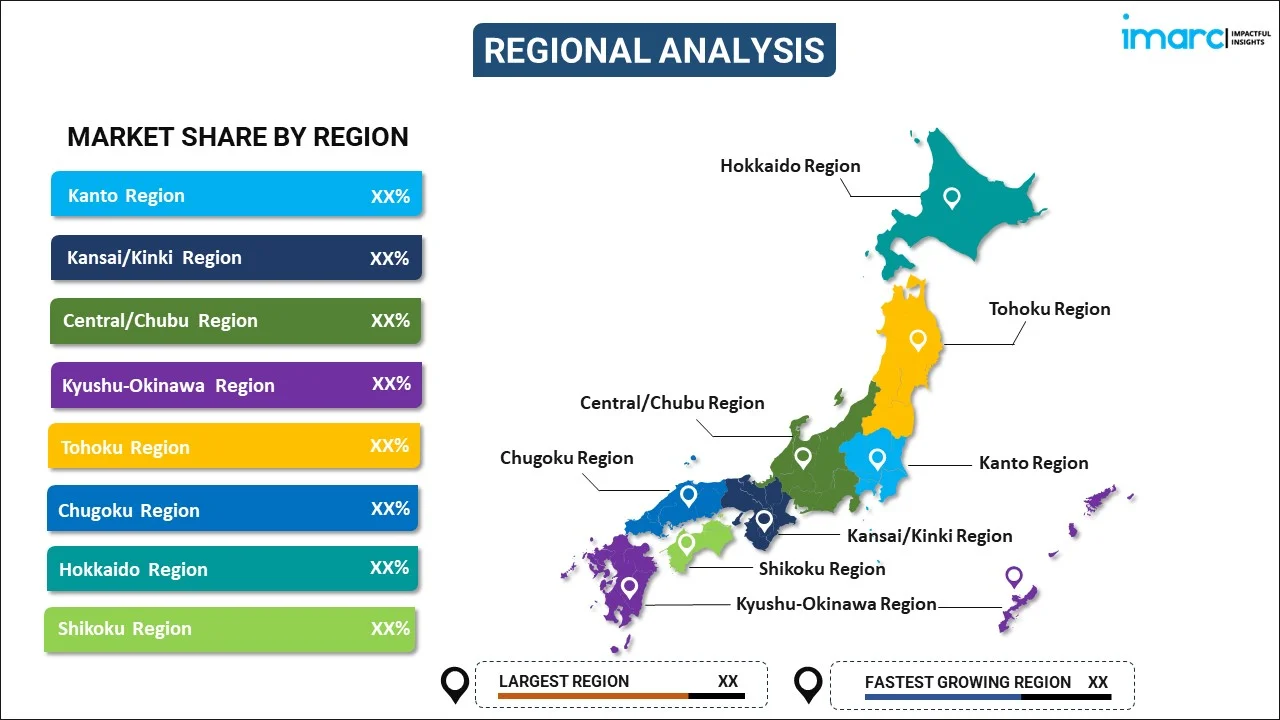
Japan Aircraft Sensors Market Report by Aircraft Type (Fixed Wings, Rotorcraft, and Others), Sensor Type (Proximity Sensors, Temperature Sensors, Optical Sensors, Pressure Sensors, Force Sensors, Flow Sensors, Radar Sensors, and Others), Connectivity (Wired Sensors, Wireless Sensors), Application (Flight Decks, Landing Gear Systems, Weapon Systems, Fuel, Hydraulic, and Pneumatic Systems, Engine/Propulsion, Cabin and Cargo Environmental Controls, Aerostructures and Flight Control, and Others), End Use (OEM, Aftermarket), and Region 2025-2033
Market Overview:
Japan aircraft sensors market size is projected to exhibit a growth rate (CAGR) of 4.21% during 2025-2033. The expanding aviation industry due to several factors, such as rising air travel demand and fleet expansion, which leads to an increased need for primary sensors in new aircraft manufacturing, is driving the market.
|
Report Attribute
|
Key Statistics
|
|---|---|
|
Base Year
|
2024 |
|
Forecast Years
|
2025-2033 |
|
Historical Years
|
2019-2024
|
| Market Growth Rate (2025-2033) | 4.21% |
Aircraft sensors play a pivotal role in the safe and efficient operation of modern aviation. These sophisticated devices are designed to monitor various parameters and provide critical data to pilots and aircraft systems. One of the most crucial sensors on an aircraft is the airspeed sensor, which measures the aircraft's velocity through the air. This information is essential for maintaining proper flight control and preventing stalls. Altitude sensors, like altimeters and pressure sensors, help pilots determine their aircraft's height above sea level, ensuring they maintain the correct altitude during flight. Temperature sensors ensure that critical components, such as engines and avionics, operate within their specified temperature ranges. Meanwhile, gyroscopes and accelerometers provide valuable data for flight stabilization and navigation, helping pilots maintain course and control in challenging conditions. Additionally, sensors for detecting smoke, fire, and toxic gases are vital for passenger safety. Overall, aircraft sensors work in the background to ensure the safety, performance, and reliability of aircraft, making air travel one of the safest transportation modes.
Japan Aircraft Sensors Market Trends:
The aircraft sensors market in Japan is poised for substantial growth in the coming years, primarily driven by several key factors. To begin with, the increasing emphasis on aviation safety is a significant driver. This has led to a surge in the demand for advanced sensors that can provide real-time data on various parameters, ensuring safer flights. Moreover, the rapid advancements in sensor technology play a pivotal role in market growth. Continuous innovations in sensor design and functionality have enabled aircraft manufacturers to incorporate more sophisticated sensors into their aircraft, thereby improving their overall performance and efficiency. Furthermore, the growing need for fuel efficiency is another critical driver. Airlines are constantly striving to reduce operating costs and minimize their environmental footprint. Aircraft sensors enable better monitoring of engine performance, fuel consumption, and overall aircraft health, contributing to improved fuel efficiency and reduced emissions. Additionally, the increasing adoption of unmanned aerial vehicles (UAVs) in various applications, such as surveillance, agriculture, and delivery services, is boosting the demand for specialized sensors tailored to UAV requirements. All these factors combined are expected to propel the regional aircraft sensors market forward in the foreseeable future.
Japan Aircraft Sensors Market Segmentation:
IMARC Group provides an analysis of the key trends in each segment of the market, along with forecasts at the country level for 2025-2033. Our report has categorized the market based on aircraft type, sensor type, connectivity, application, and end use.
Aircraft Type Insights:

- Fixed Wings
- Rotorcraft
- Others
The report has provided a detailed breakup and analysis of the market based on the aircraft type. This includes fixed wings, rotorcraft, and others.
Sensor Type Insights:
- Proximity Sensors
- Temperature Sensors
- Optical Sensors
- Pressure Sensors
- Force Sensors
- Flow Sensors
- Radar Sensors
- Others
A detailed breakup and analysis of the market based on the sensor type have also been provided in the report. This includes proximity sensors, temperature sensors, optical sensors, pressure sensors, force sensors, flow sensors, radar sensors, and others.
Connectivity Insights:
- Wired Sensors
- Wireless Sensors
The report has provided a detailed breakup and analysis of the market based on the connectivity. This includes wired sensors and wireless sensors.
Application Insights:
- Flight Decks
- Landing Gear Systems
- Weapon Systems
- Fuel, Hydraulic, and Pneumatic Systems
- Engine/Propulsion
- Cabin and Cargo Environmental Controls
- Aerostructures and Flight Control
- Others
A detailed breakup and analysis of the market based on the application have also been provided in the report. This includes flight decks, landing gear systems, weapon systems, fuel, hydraulic, and pneumatic systems, engine/propulsion, cabin and cargo environmental controls, aerostructures and flight control, and others.
End Use Insights:
- OEM
- Aftermarket
The report has provided a detailed breakup and analysis of the market based on the end use. This includes OEM and aftermarket.
Regional Insights:

- Kanto Region
- Kansai/Kinki Region
- Central/ Chubu Region
- Kyushu-Okinawa Region
- Tohoku Region
- Chugoku Region
- Hokkaido Region
- Shikoku Region
The report has also provided a comprehensive analysis of all the major regional markets, which include Kanto Region, Kansai/Kinki Region, Central/ Chubu Region, Kyushu-Okinawa Region, Tohoku Region, Chugoku Region, Hokkaido Region, and Shikoku Region.
Competitive Landscape:
The market research report has also provided a comprehensive analysis of the competitive landscape. Competitive analysis such as market structure, key player positioning, top winning strategies, competitive dashboard, and company evaluation quadrant has been covered in the report. Also, detailed profiles of all major companies have been provided.
Japan Aircraft Sensors Market Report Coverage:
| Report Features | Details |
|---|---|
| Base Year of the Analysis | 2024 |
| Historical Period | 2019-2024 |
| Forecast Period | 2025-2033 |
| Units | Million USD |
| Scope of the Report | Exploration of Historical Trends and Market Outlook, Industry Catalysts and Challenges, Segment-Wise Historical and Future Market Assessment:
|
| Aircraft Types Covered | Fixed Wings, Rotorcraft, Others |
| Sensor Types Covered | Proximity Sensors, Temperature Sensors, Optical Sensors, Pressure Sensors, Force Sensors, Flow Sensors, Radar Sensors, Others |
| Connectivities Covered | Wired Sensors, Wireless Sensors |
| Applications Covered | Flight Decks, Landing Gear Systems, Weapon Systems, Fuel, Hydraulic, and Pneumatic Systems, Engine/Propulsion, Cabin and Cargo Environmental Controls, Aerostructures and Flight Control, Others |
| End Uses Covered | OEM, Aftermarket |
| Regions Covered | Kanto Region, Kansai/Kinki Region, Central/ Chubu Region, Kyushu-Okinawa Region, Tohoku Region, Chugoku Region, Hokkaido Region, Shikoku Region |
| Customization Scope | 10% Free Customization |
| Post-Sale Analyst Support | 10-12 Weeks |
| Delivery Format | PDF and Excel through Email (We can also provide the editable version of the report in PPT/Word format on special request) |
Key Questions Answered in This Report:
- How has the Japan aircraft sensors market performed so far and how will it perform in the coming years?
- What has been the impact of COVID-19 on the Japan aircraft sensors market?
- What is the breakup of the Japan aircraft sensors market on the basis of aircraft type?
- What is the breakup of the Japan aircraft sensors market on the basis of sensor type?
- What is the breakup of the Japan aircraft sensors market on the basis of connectivity?
- What is the breakup of the Japan aircraft sensors market on the basis of application?
- What is the breakup of the Japan Aircraft sensors market on the basis of end use?
- What are the various stages in the value chain of the Japan aircraft sensors market?
- What are the key driving factors and challenges in the Japan aircraft sensors?
- What is the structure of the Japan aircraft sensors market and who are the key players?
- What is the degree of competition in the Japan aircraft sensors market?
Key Benefits for Stakeholders:
- IMARC’s industry report offers a comprehensive quantitative analysis of various market segments, historical and current market trends, market forecasts, and dynamics of the Japan aircraft sensors market from 2019-2033.
- The research report provides the latest information on the market drivers, challenges, and opportunities in the Japan aircraft sensors market.
- Porter's five forces analysis assist stakeholders in assessing the impact of new entrants, competitive rivalry, supplier power, buyer power, and the threat of substitution. It helps stakeholders to analyze the level of competition within the Japan aircraft sensors industry and its attractiveness.
- Competitive landscape allows stakeholders to understand their competitive environment and provides an insight into the current positions of key players in the market.
Need more help?
- Speak to our experienced analysts for insights on the current market scenarios.
- Include additional segments and countries to customize the report as per your requirement.
- Gain an unparalleled competitive advantage in your domain by understanding how to utilize the report and positively impacting your operations and revenue.
- For further assistance, please connect with our analysts.
 Inquire Before Buying
Inquire Before Buying
 Speak to an Analyst
Speak to an Analyst
 Request Brochure
Request Brochure
 Request Customization
Request Customization




.webp)




.webp)












